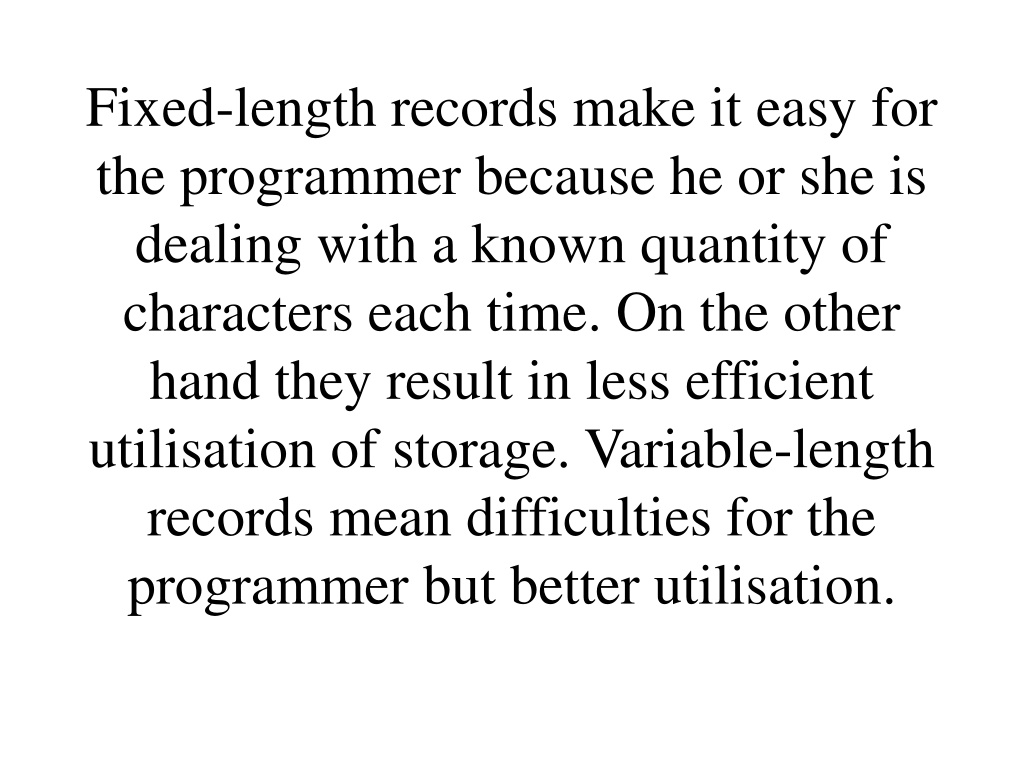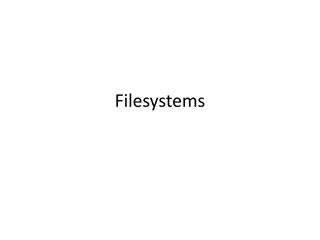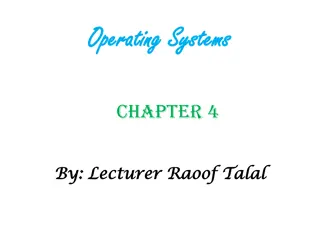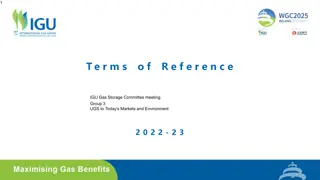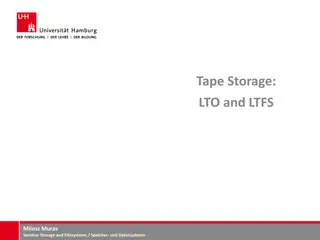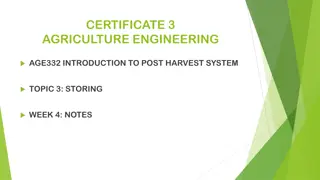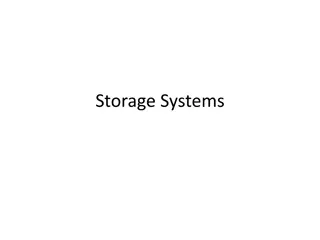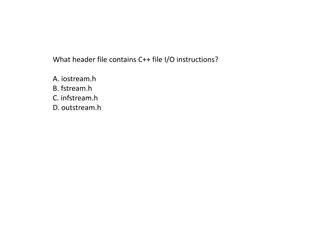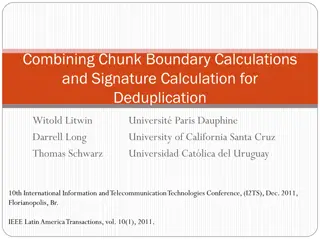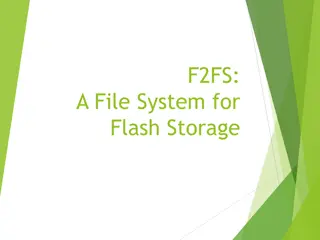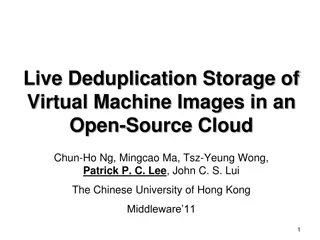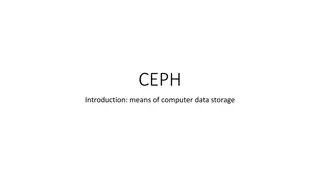Understanding File Characteristics and Efficient Storage Methods
Fixed-length records simplify programming by dealing with a known quantity of characters each time but result in less storage efficiency. Variable-length records offer better storage utilization despite posing challenges for programmers. Apart from hit rate and activity, file characteristics like volatility, size, and growth need consideration for effective file management. File processing, although still using magnetic tapes for backup, mainly occurs on mainframes in large institutions.
Download Presentation

Please find below an Image/Link to download the presentation.
The content on the website is provided AS IS for your information and personal use only. It may not be sold, licensed, or shared on other websites without obtaining consent from the author. Download presentation by click this link. If you encounter any issues during the download, it is possible that the publisher has removed the file from their server.
E N D
Presentation Transcript
Fixed-length records make it easy for the programmer because he or she is dealing with a known quantity of characters each time. On the other hand they result in less efficient utilisation of storage. Variable-length records mean difficulties for the programmer but better utilisation.
terms of active records. For example, if 1,000 transactions are processed each day against a master file of 10,000 records, then the hit rate is said to be 10%. Hit rate is a measure of the "activity" of the file.
Apart from activity, which is measured by hit rate, there are other characteristics of the file that need to be considered. These are:
a. Volatility. This is the frequency with which records are added to the file or deleted
from it. If the frequency is high, the file is said to be volatile. A file that is not
low, the file is said to be "semi- static". b. Size. This is the amount of data stored in the file. It may be expressed in terms c. Growth. Files often grow steadily in size as new records are added. Growth must be allowed for when planning how to store a file. of the number of characters or number of records.
Student self-test questions Introduction in a master file. Comment on the probable characteristics of the file a. Volatility, b. Activity, c. Size, d. Growth. There is still some file processing carried out using files stored on magnetic tape but it is almost all done on mainframes in large commercial, industrial or financial institutions. Magnetic tape continues to be an important backup medium especially in its cartridge forms. The simplest methods of organising and accessing files on disk are very similar to the standard ones used for magnetic tape. Where appropriate this similarity will be drawn to the reader's attention. Otherwise little mention will be made of magnetic tape. Instead, some additional details are included in Appendix 2 for the minority of readers who may need them. File organisation is the arrangement of records within a particular file. We start from the point where the individual physical record layout has been already designed, ie, the file "structure" has already been decided. How do we organise our many hundreds, or even thousands, of such records (eg, customer records) on disk? When we wish to access one or more of the records how do we do it? This segment explains how these things are done. In order to process files stored on disk the disk cartridge pack must first be loaded into a disk unit. For a fixed disk the disk is permanently in the disk unit. Records are "written" onto a disk as the disk pack revolves at a constant speed within its disk unit. Each record is written in response to a "write" instruction, Data goes from main storage through a read- write head onto a track on the disk surface. Records are recorded one after the other on each track. (On magnetic tape the records are also written one after the other along the tape.) In order to process files stored on disk the disk cartridge or pack must first be loaded into a disk unit. Records are read from the disk as it revolves at a constant speed. Each record is read in response to a "read" instruction. Data goes from the disk to the main storage through the read-write head already mentioned. Both reading and writing of data are accomplished at a fixed number (thousands) of bytes per second. W e will take for our discussion on file organisation a "6-disk" pack, meaning it has ten usable surfaces (the outer two are not used for recording purposes). But before describing how files are organised let us look first at the basic underlying concepts. In the case of a floppy disk the situation is essentially the same but simpler. There is just one recording surface on a "single-sided" floppy disk and two recording surfaces on a "double-sided" floppy disk. The other significant differences are in terms of capacity and speed. Use is made of the physical features already described when organising the storage of records on disk. Records are written onto the disk starting with track 1 on surface 1, then track 1 on surface 2, then track 1 on surface 3 and so on to track I on surface 10. One can see that conceptually the ten tracks of data can be regarded as forming a CYLINDER. b. track number Thus the address 1900403 indicates i. cylinder 190 ii. track 04 ii. block 03 b. track number Thus the address 1900403 indicates i. cylinder 190 ii. track 04 ii. block 03 ii. Selective sequential. Again the transaction file must be pre-sorted into the same sequence as the master file. The transaction file is processed against the master file and only those master records for which there is a transaction are selected. Notice that the access mechanism is going forward in an ordered progression (never backtracking) because both files are in the same sequence. This minimises head movement and saves processing time. This method is suitable when the hit rate is low, as only those records for which there is a transaction are accessed. in. Random. Transactions are processed in a sequence that is not that of the master file. The transactions may be in another sequence, or may be unsequenced. In contrast to the selective sequential method, the access mechanism will move not in an ordered progression but back and forth along the file. Here the index is used when transactions are processed immediately - ie, there is not time to assemble files and sort them into sequence. It is also used when updating two files simultaneously. For example, a transaction file of orders might be used to update a stock file and a customer file during the same run. If the order was sorted to customer sequence, the customer file would be updated on a selective sequential basis and the stock file on a random basis. (Examples will be given in later segments.) Note. In c.i and c.ii the ordered progression of the heads relies upon an orderly organisation of the data and no other program performing reads from the disk at the same time, which would cause head movement to other parts of the disk. In multi-user systems these things cannot always be relied upon. d. Random files. Generally speaking the method of access to random files is RANDOM. The transaction record keys will be put through the same mathematical formula as were the keys of the master records, thus creating the appropriate bucket address. The transactions in random order are then processed against the master file, the bucket address providing the address of the record required. b. Address generation: The record keys are applied to a mathematical formula that has been designed to generate a disk hardware address. The formula is very difficult to design and the reader need not worry about it. The master records are placed on the disk at the addresses generated. Access is afterwards obtained by generating the disk address for each transaction. c. Record key = disk address. It would be convenient if we could use the actual disk hardware address as our record key. Our transaction record keys would then also be the appropriate disk addresses and thus no preliminary action such as searching an index or address generation would be required in order to access the appropriate master records. This is not a very practical method, however, and has very limited application. b. Updating a master file entails the following: iii. A master record is read into main storage and written straight out again on a new file if it does not match the transaction. Successive records from the master file are read (and
